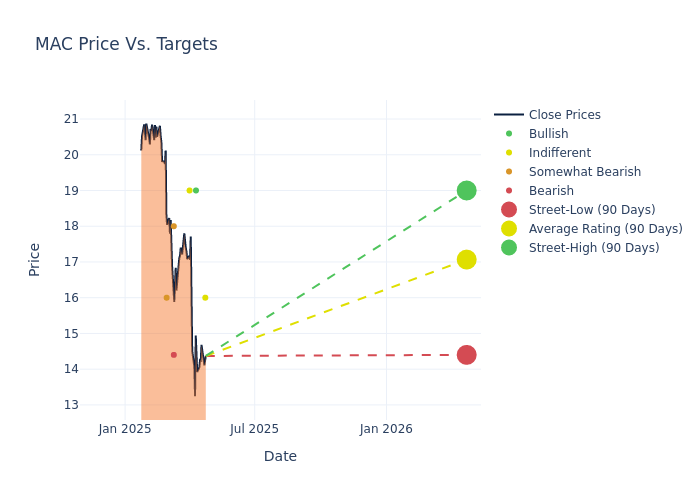
In the latest quarter, 8 analysts provided ratings for Macerich (NYSE:MAC), showcasing a mix of bullish and bearish perspectives.
The following table summarizes their recent ratings, shedding light on the changing sentiments within the past 30 days and comparing them to the preceding months.
| Bullish | Somewhat Bullish | Indifferent | Somewhat Bearish | Bearish | |
|---|---|---|---|---|---|
| Total Ratings | 1 | 0 | 4 | 2 | 1 |
| Last 30D | 0 | 0 | 1 | 0 | 0 |
| 1M Ago | 1 | 0 | 2 | 0 | 0 |
| 2M Ago | 0 | 0 | 1 | 2 | 1 |
| 3M Ago | 0 | 0 | 0 | 0 | 0 |
Analysts have recently evaluated Macerich and provided 12-month price targets. The average target is $17.8, accompanied by a high estimate of $21.00 and a low estimate of $14.40. This current average represents a 11.4% decrease from the previous average price target of $20.09.

Deciphering Analyst Ratings: An In-Depth Analysis
The standing of Macerich among financial experts is revealed through an in-depth exploration of recent analyst actions. The summary below outlines key analysts, their recent evaluations, and adjustments to ratings and price targets.
| Analyst | Analyst Firm | Action Taken | Rating |Current Price Target| Prior Price Target | |--------------------|--------------------|---------------|---------------|--------------------|--------------------| |Nicholas Yulico |Scotiabank |Lowers |Sector Perform | $16.00|$21.00 | |Ki Bin Kim |Truist Securities |Maintains |Buy | $19.00|$19.00 | |Ronald Kamdem |Morgan Stanley |Lowers |Equal-Weight | $19.00|$20.00 | |Ki Bin Kim |Truist Securities |Lowers |Hold | $19.00|$23.00 | |Caitlin Burrows |Goldman Sachs |Lowers |Sell | $14.40|$16.70 | |Michael Mueller |JP Morgan |Lowers |Underweight | $18.00|$22.00 | |Nicholas Yulico |Scotiabank |Lowers |Sector Perform | $21.00|$22.00 | |Alexander Goldfarb |Piper Sandler |Lowers |Underweight | $16.00|$17.00 |
Key Insights:
- Action Taken: Analysts frequently update their recommendations based on evolving market conditions and company performance. Whether they 'Maintain', 'Raise' or 'Lower' their stance, it reflects their reaction to recent developments related to Macerich. This information provides a snapshot of how analysts perceive the current state of the company.
- Rating: Gaining insights, analysts provide qualitative assessments, ranging from 'Outperform' to 'Underperform'. These ratings reflect expectations for the relative performance of Macerich compared to the broader market.
- Price Targets: Analysts set price targets as an estimate of a stock's future value. Comparing the current and prior price targets provides insight into how analysts' expectations have changed over time. This information can be valuable for investors seeking to understand consensus views on the stock's potential future performance.
Navigating through these analyst evaluations alongside other financial indicators can contribute to a holistic understanding of Macerich's market standing. Stay informed and make data-driven decisions with our Ratings Table.
Stay up to date on Macerich analyst ratings.
Get to Know Macerich Better
Macerich invests in premium mall assets. The company owns 30 regional malls in its consolidated portfolio and 10 regional malls in its unconsolidated portfolio along with two power centers and seven other real estate assets. The company's total portfolio has 42.9 million square feet of gross leasable area and averaged $837 sales per square foot over the 12 months ended in December 2024.
Financial Milestones: Macerich's Journey
Market Capitalization Analysis: The company's market capitalization is below the industry average, suggesting that it is relatively smaller compared to peers. This could be due to various factors, including perceived growth potential or operational scale.
Revenue Growth: Macerich's revenue growth over a period of 3M has been noteworthy. As of 31 December, 2024, the company achieved a revenue growth rate of approximately 14.66%. This indicates a substantial increase in the company's top-line earnings. When compared to others in the Real Estate sector, the company excelled with a growth rate higher than the average among peers.
Net Margin: Macerich's net margin lags behind industry averages, suggesting challenges in maintaining strong profitability. With a net margin of -77.27%, the company may face hurdles in effective cost management.
Return on Equity (ROE): Macerich's ROE lags behind industry averages, suggesting challenges in maximizing returns on equity capital. With an ROE of -8.03%, the company may face hurdles in achieving optimal financial performance.
Return on Assets (ROA): Macerich's ROA falls below industry averages, indicating challenges in efficiently utilizing assets. With an ROA of -2.62%, the company may face hurdles in generating optimal returns from its assets.
Debt Management: The company maintains a balanced debt approach with a debt-to-equity ratio below industry norms, standing at 1.84.
The Significance of Analyst Ratings Explained
Benzinga tracks 150 analyst firms and reports on their stock expectations. Analysts typically arrive at their conclusions by predicting how much money a company will make in the future, usually the upcoming five years, and how risky or predictable that company's revenue streams are.
Analysts attend company conference calls and meetings, research company financial statements, and communicate with insiders to publish their ratings on stocks. Analysts typically rate each stock once per quarter or whenever the company has a major update.
Analysts may supplement their ratings with predictions for metrics like growth estimates, earnings, and revenue, offering investors a more comprehensive outlook. However, investors should be mindful that analysts, like any human, can have subjective perspectives influencing their forecasts.
Which Stocks Are Analysts Recommending Now?
Benzinga Edge gives you instant access to all major analyst upgrades, downgrades, and price targets. Sort by accuracy, upside potential, and more. Click here to stay ahead of the market.
This article was generated by Benzinga's automated content engine and reviewed by an editor.